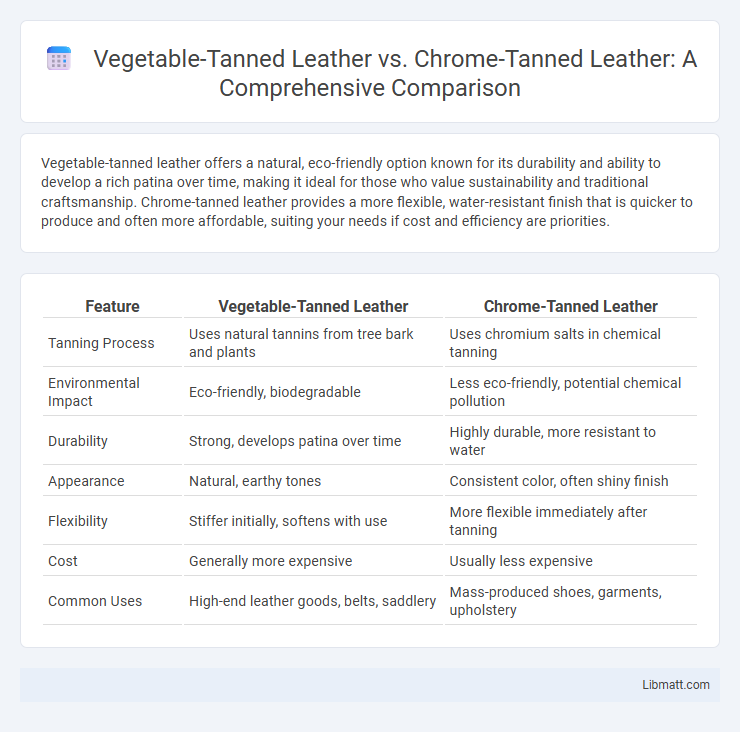Vegetable-tanned leather offers a natural, eco-friendly option known for its durability and ability to develop a rich patina over time, making it ideal for those who value sustainability and traditional craftsmanship. Chrome-tanned leather provides a more flexible, water-resistant finish that is quicker to produce and often more affordable, suiting your needs if cost and efficiency are priorities.
Table of Comparison
| Feature | Vegetable-Tanned Leather | Chrome-Tanned Leather |
|---|---|---|
| Tanning Process | Uses natural tannins from tree bark and plants | Uses chromium salts in chemical tanning |
| Environmental Impact | Eco-friendly, biodegradable | Less eco-friendly, potential chemical pollution |
| Durability | Strong, develops patina over time | Highly durable, more resistant to water |
| Appearance | Natural, earthy tones | Consistent color, often shiny finish |
| Flexibility | Stiffer initially, softens with use | More flexible immediately after tanning |
| Cost | Generally more expensive | Usually less expensive |
| Common Uses | High-end leather goods, belts, saddlery | Mass-produced shoes, garments, upholstery |
Introduction to Leather Tanning Methods
Vegetable-tanned leather utilizes natural tannins from plant sources such as tree bark and leaves, resulting in a durable, eco-friendly material with a rich, natural patina that improves over time. Chrome-tanned leather employs chromium salts, offering enhanced flexibility, water resistance, and faster production, making it widely used in mass-market leather goods. Both tanning methods significantly impact the leather's texture, durability, environmental footprint, and suitability for various applications in fashion and upholstery industries.
What is Vegetable-Tanned Leather?
Vegetable-tanned leather is tanned using natural tannins found in plant materials such as tree bark, leaves, and fruits, resulting in a durable and environmentally friendly product. This tanning process can take several weeks, producing leather that is firm, develops a rich patina over time, and is biodegradable. Unlike chrome-tanned leather, which uses chemical agents for quicker processing, vegetable-tanned leather is favored for artisanal crafts and eco-conscious consumers due to its natural origins and longevity.
What is Chrome-Tanned Leather?
Chrome-tanned leather is a type of leather treated with chromium salts, primarily chromium sulfate, which accelerates the tanning process to just a few days. This method produces leather that is more water-resistant, flexible, and softer compared to vegetable-tanned leather. Due to its durability and color retention, chrome-tanned leather is commonly used in fashion, upholstery, and accessories.
The Tanning Process: Vegetable vs Chrome
Vegetable-tanned leather undergoes a natural tanning process using plant-based tannins extracted from tree bark, leaves, and fruits, which slowly penetrates the hide over weeks, resulting in firm, durable, and eco-friendly leather. Chrome-tanned leather is treated with chromium salts in a shorter, industrial process lasting only a few days, producing softer, more water-resistant leather with higher uniformity but a more significant environmental footprint. Your choice between the two depends on whether you prioritize sustainability and aging character (vegetable-tanned) or speed, flexibility, and water resistance (chrome-tanned).
Durability and Aging Differences
Vegetable-tanned leather is known for developing a rich patina over time, improving in appearance and softness with age, whereas chrome-tanned leather maintains a consistent look but tends to wear out faster. Durability in vegetable-tanned leather is high due to its natural tanning process, making it more resistant to stretching and abrasion compared to chrome-tanned leather, which can be weaker under prolonged use. The aging process in vegetable tanning enhances character and texture, while chrome tanning often results in a less dynamic, more synthetic-like aging experience.
Environmental Impact Comparison
Vegetable-tanned leather utilizes natural tannins from tree bark and plant extracts, producing a biodegradable material with minimal chemical waste, making it more environmentally friendly compared to chrome-tanned leather. Chrome-tanned leather relies on chromium salts, which can release harmful pollutants into water systems if not properly managed, contributing to soil and water contamination. The longer processing time and sustainable raw materials used in vegetable tanning reduce ecological footprints, while chrome tanning offers faster production but poses greater environmental risks.
Appearance and Texture Contrast
Vegetable-tanned leather boasts a natural, rich patina that deepens with age, featuring a firm and slightly textured surface that highlights organic grain patterns. Chrome-tanned leather offers a smoother, more consistent finish with vibrant color options and a supple, softer texture due to chemical tanning processes. Your choice depends on whether you prefer the rugged authenticity of vegetable tanning or the sleek uniformity of chrome tanning.
Cost and Market Availability
Vegetable-tanned leather typically costs more due to the lengthy, eco-friendly tanning process using natural tannins from tree bark, making it less available in mass-market products compared to chrome-tanned leather. Chrome-tanned leather is more widely available and affordable because it uses chromium salts, allowing for faster tanning and large-scale production. Market demand favors chrome-tanned leather for its cost-effectiveness and versatility in fashion and upholstery, while vegetable-tanned leather is preferred in niche markets emphasizing sustainability and artisanal craftsmanship.
Best Uses for Each Leather Type
Vegetable-tanned leather is ideal for high-quality leather goods such as wallets, belts, and saddlery due to its durability, natural aging process, and eco-friendly tanning method. Chrome-tanned leather suits mass-produced items like fashion footwear, upholstery, and handbags because of its softness, flexibility, and water-resistant properties. Understanding these distinctions helps manufacturers and consumers select leather types that align with product longevity, aesthetic preferences, and environmental impact considerations.
Choosing the Right Leather for Your Needs
Vegetable-tanned leather offers natural durability, develops a unique patina over time, and is eco-friendly due to its use of tannins from plant sources, while chrome-tanned leather provides greater flexibility, water resistance, and a more consistent color finish. Your choice depends on whether you prioritize sustainability and aging aesthetics or prefer durability and cost-effectiveness in mass production. Understanding the distinct tanning methods helps you select leather that best suits your daily use and environmental values.
Vegetable-tanned leather vs chrome-tanned leather Infographic

 libmatt.com
libmatt.com